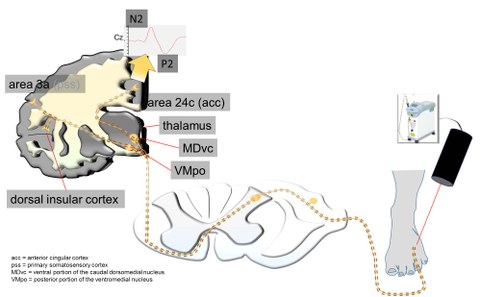Projects
New electrophysiological procedures emerged during the past years, which are able to assess the sensory nervous system on a modality-specific basis. For instance, heat-mediating nerve fibres may be selectively measured by applying short lasting standardized heat stimuli and consecutive EEG potential analyses. Laser-evoked potentials are proposed as “gold-standard” for the measurement of small fibres and were validated in various disorders with the affection of the sensory nervous system.

Figure 1: Laser-evoked potentials
Our primary goal is the research and validation of new electrophysiological procedures, which are capable of selectively measuring all known nerve fiber modalities (such as cold-mediating fibres, heat-mediating fibres, warm-mediating, and mechanical pain mediating fibres). With this approach it might be possible to reveal sensory deficits in the early stage of disease, adapt early treatment, and avoid irreversible damage of the sensory system. This could improve quality of life, reduce pain and economic costs.
Main topics of the research group Pain Neurophysiology are:
Establishing cold-evoked potentials for clinical use
Polyneuropathy is one of the most common neurological diseases, which affects pain sensation, mobility, functionality, and quality of life in patients. Up to 16% of 70 years old human beings suffer from polyneuropathy. In the early stage of disease, common electrophysiological diagnostic procedures are not capable to assess nerve fiber alterations. Especially the integrity of small-nerve fibers and the spino-thalamic tract cannot be tested by nerve conduction studies or somatosensory evoked potentials. Nevertheless, it is essential to drive treatment decisions in the very early stage of disease in order to prevent further damage to the somatosensory system.
The majority of polyneuropathy patients suffers from cold detection loss as early sign of disease. So far, the integrity of cold mediating fibers has not been assessable by objective electrophysiological diagnostic tools.
Cold-evoked potentials (CEP) provide a valuable new diagnostic tool, which enables early detection of small-fiber function loss. This is an important prerequisite for measuring the early stage of disease, when patients report tingling sensations or quality of life affecting pain while physicians cannot detect any sensory abnormities. The early quantification of these sensory abnormalities with CEP may optimize medical treatment (such as antidiabetic drugs, vitamin substitution, avoidance of toxic agents, enzyme therapy for Fabry’s disease, etc.) and prevent further somatosensory damage.
New selective electrophysiological tools assess the entire somatosensory nervous system
New electrophysiological procedures emerged within the last years, which are capable of assessing nerve fiber function loss objectively. Some of these procedures, such as the somatosensory-evoked potentials (measurement of touch mediating fibres) or the laser-evoked potentials (measurement of heat pain mediation fibres) are used in clinical routine. Other procedures, such as warm-evoked potentials, pinprick-evoked potentials or cold-evoked potentials are investigated in scientific laboratories in order to improve the understanding of the signal processing of different nerve fiber sub-classes in the central nervous system.
The aim of the present project is the electrophysiological assessment of all known nerve fiber modalities with evoked potentials. Different stimulus modalities (e.g. touch, heat, cold, warm) will be applied and stimulus-specific signals will be recorded and analysed with EEG.

Figure 2: Example of a somatosensory profile including most relevant nerve fiber modalities.
Detecting abnormal central pain processing
Peripheral and central sensitization are important factors which may induce pain chronicity. In healthy subjects, the central nervous system is capable of decreasing pain intensity when repetitive painful stimuli are applied due to endogenous pain inhibition and central pain signal modulation. Another term for adaptation to continuously applied pain stimuli is habituation. So far, pain research used the individual subjective pain rating (numeric analogue scale, visual analogue scale) to visualize habituation (decrease of subjective pain over time).
A new scientific approach is the induction of central habituation by repetitive painful laser stimuli, which are synchronized with EEG to analyse Laser-evoked potentials (LEP). Repetitive painful laser stimuli induce a continuous decrease of the subjective pain rating and the LEP-amplitude over time, i.e. LEP-habituation. This LEP-habituation phenomenon affects both hemispheres as well as the central signal processing of different nerve fibre sub-classes.
In patients with nociceptive and neuropathic pain, LEP-habituation is substantially reduced in comparison to healthy controls, which points to an abnormal central pain processing. Central sensitization seems to oppose physiological LEP-habituation.

Figure 3: The comparison of LEP-habituation of painful radiculopathy patients versus healthy controls is shown here. Reduced LEP-habituation was found in the patient group as sign of abnormal central pain processing. Patients with signs of central sensitization showed a further decreased LEP-habituation indicating that central sensitization seems to be a major contributor of abnormal central pain processing.
The present project investigates whether the assessment of LEP-habituation may be used as diagnostic tool in order to detect abnormal central pain processing electrophysiologically. Being able to document abnormal central pain processing, might enable clinicians to drive treatment decisions in the direction of centrally acting analgesic drugs. The further, the restitution of LEP-habituation might document treatment success
